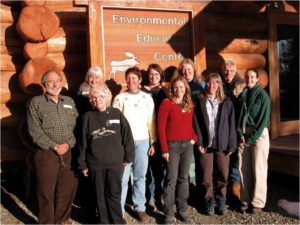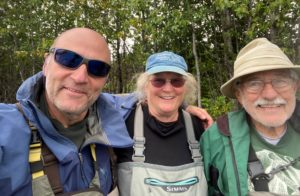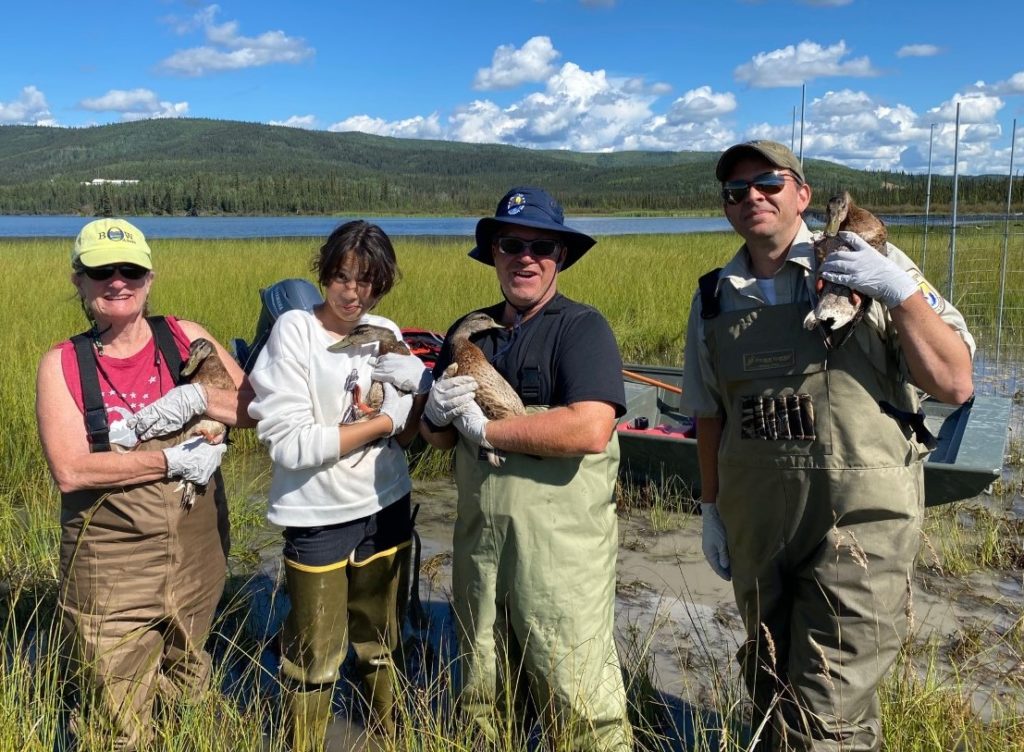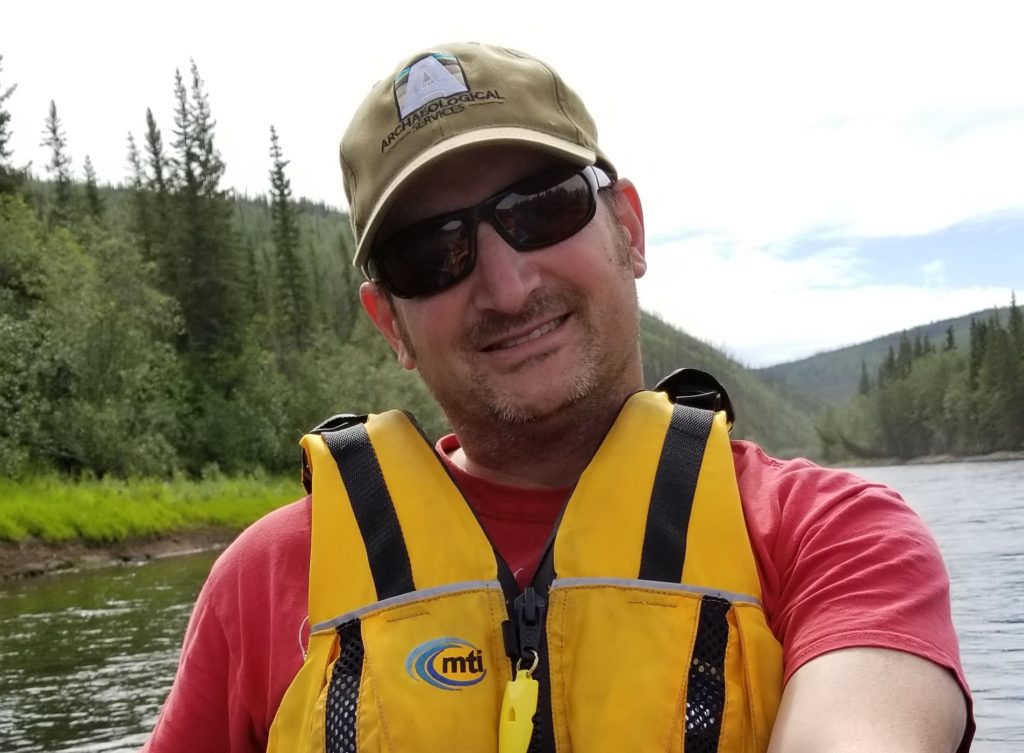By Poppy Benson, Friends Board Vice President
|
By Poppy Benson, Friends Board Vice President
|
by Poppy Benson, Friends Board Vice President
From a Ducks Unlimited Banquet in Bethel to The Month of the Military Child in Fairbanks, Friends were reaching out to new and old audiences spreading the word about Friends and Alaska’s incredible 16 National Wildlife Refuges.
Birders flocked to the Kachemak Bay Shorebird Festival in Homer in early May giving us our biggest opportunity to recruit new members and talk up all the refuges beyond the Alaska Maritime with which we cosponsor the festival. Sixteen Friends from Soldotna, Anchorage, Homer and Colorado worked our outreach booth for 4 days signing up 40 new and renewing members. Most also volunteered with other Festival events as well. Beyond the booth, we had opportunities to reach out to this audience of Alaskans and lower 48 birders at the keynote event and again at the Birder’s Coffee which we host.
Friend Susan Watkin’s painting of a moose crossing through the refuge’s Sterling Highway wildlife underpass served as a photo booth and a highlight of the Kenai Refuge exhibit at the Sports and Recreation show in Soldotna. Five Friends under Marie McConnell’s leadership worked at a Friends table co-located with the Kenai Refuge allowing Friends to help with fun refuge activities, share their knowledge of the Kenai Refuge and recruit members. This was a different audience with important ties to the Kenai Refuge and 12 new members were recruited.
Becky Wick and Tim Shipman work the Friends booth at the Soldotna Sports and Recreation Show. The 12 new members recruited at the Show bring Friends membership in the Kenai/Soldotna area to 50. pc: Marie McConnell
Also on the Kenai, the refuge’s Greenup, Cleanup service project turned into an outreach event when Friend Becky Wick showed up with 10 members of her hiking group. Plenty of opportunities to chat about Friends while cleaning up three refuge campgrounds and access roads on Saturday and the refuge’s muti use trail on Friday. Tim Shipman, long time Team Friends organizer, remarked that the campgrounds were cleaner this year.

Although not technically an outreach event, our members turned the Kenai Refuge Greenup, Cleanup into one by inviting friends, family and a hiking club. L to R Dan Moultrie, Becky Wick, Dan Musgrove and Robin Musgrove. pc: Marie McConnell
Ten people flying from Alabama to Bethel for dinner was just one unexpected twist to our first ever Bethel outreach event. When Yukon Delta’s Refuge Manager, Boyd Blihovde, told his new Friends liaison, Ryan Peyton, that he wanted to see Friends do an event in Bethel like a Ducks Unlimited (DU) banquet, he was talking to the right guy. Ryan, a long time DU member, quickly saw the benefit in developing a relationship between the waterfowl rich refuge and the waterfowl group who has done so much for habitat conservation. Ryan hosted a Friends’ outreach table at the DU banquet adjacent to the refuge’s information table. The DU banquet is the biggest conservation event in Bethel with over 125 people attending including the 10 from Alabama. Ryan hopes he set the stage for a greater role in next year’s event and other cooperative activities with DU.
Ryan Peyton, a long time Ducks Unlimited (DU) member and Yukon Delta Refuge liaison, staffed our first ever outreach effort in Bethel at the Bethel DU Banquet. About 125 people attended including people from out of state. pc: Laurie Boeck/USFWS
Military children and families are an important part of the Fairbanks community. Due to refuge staff transfers, the northern refuges were at risk of being a no-show at the community event marking Month of the Military Child. Arctic Refuge’s Friends liaison Jeff Walter came to the rescue and singlehandedly ran the northern refuges’ booth which was visited by at least 90 people, half of them children. The focus here was not on Friends recruitment but interesting the kids and families from Fort Wainwright and Eielson Air Force Base in wildlife and wildlife refuges.
Jeff Walters, Friends Arctic Refuge liaison, was the sole staffer for the northern refuges booth at a Fairbanks community event celebrating the Month of the Military Child. About 90 people, half of them children, stopped at his table.
This spring was an exciting time of growth for Friends outreach due to the new audiences, diversity of locations and sheer numbers of Friends who volunteered. Thanks to all who helped.

 Caroline Brouwer was appointed to a new position of a second Vice-President which we amended our bylaws to include. Caroline has served on the Board since 2020 and has been involved in advocacy for the National Wildlife Refuge System since 2008, lobbying on behalf of funding increases for the Refuge System and policy changes. She spent 14 years working in Washington, DC on behalf of public lands advocacy and national wildlife refuges with Ducks Unlimited and the National Wildlife Refuge Association.
Caroline Brouwer was appointed to a new position of a second Vice-President which we amended our bylaws to include. Caroline has served on the Board since 2020 and has been involved in advocacy for the National Wildlife Refuge System since 2008, lobbying on behalf of funding increases for the Refuge System and policy changes. She spent 14 years working in Washington, DC on behalf of public lands advocacy and national wildlife refuges with Ducks Unlimited and the National Wildlife Refuge Association. by Mike Schantz, Friends Advocacy Committee
|
David was there when Friends was created at a meeting at the Kenai Refuge in 2005. He volunteered to be the first president and has been the only president for all but two years of our history. During his tenure, Friends grew from an organization of a few dozen people to the 315 members we have today. Our volunteer, advocacy and education programs have increased exponentially under his leadership.

David (on left) at the founding of Friends in 2005 at the Environmental Education Center at the Kenai National Wildlife Refuge. pc.USFWS
In his advocacy work, David has attended many meetings with the Alaska Congressional delegation, testified before Congress and at public meetings in Alaska, submitted many beautifully written and persuasive comment letters on refuge planning documents and issues under review and formed alliances with other conservation partners. He was the author of advocacy column in this newsletter which sought to keep all of us up to date on refuge issues. Principal issues he was engaged in included proposed oil and gas development in the Arctic Refuge, the proposed road through Izembek Refuge and a proposed gutting of Kenai Refuge regulations. He made a point of visiting many of Alaska’s 16 refuges and cultivated relationships with Fish and Wildlife staff in the Anchorage regional office and on individual refuges. David’s first-hand knowledge of refuge lands and the people responsible for managing them, increased our effectiveness in advocacy and support of the Refuges.

David (on left) receiving the Outstanding Friends Group of the Year Award in 2010 in Washington D.C. from the National Wildlife Refuge Association. David’s wife Marga is next to him and founding “mothers” Sharon Baur, Ginny Harris, Betty Siegel and Patricia Wood. Then Secretary of the Interior Ken Salazar is behind Ginny. pc:USFWS

We as a Board will miss the wise counsel and deep knowledge that David has contributed to our work for the last 18 years. His passion for wildlife refuges and the success of the System in Alaska has been an inspiration to us all.
Thank you David!
Alaska’s Resource Protection Teams: Patrol Captain/ Canine Handler Rob Barto with Eider and Senior Federal Wildlife Officer/ Canine Handler Pete Harvey with Togo. pc. Lisa Hupp
Imagine you are a Federal Wildlife Officer on a very busy National Wildlife Refuge. You just received a call from a concerned citizen stating they heard gunshots near a refuge lake while they were observing nesting migratory birds. The bird watcher stated they saw a huge flock of birds leave their nests as soon as the shots were fired. When the flock cleared, three birds lay motionless on the ground. It was not hunting season.
You respond to the area and try to locate the individuals responsible, but they are gone. So begins your investigation. The large lake is surrounded with high grasses. You follow a trail of flattened down grass to an area where it looks like someone had laid down. You search in vain through the grass to try and locate any shell casings or other evidence. Where do you go from here?
You know that the U.S. Fish and Wildlife Service (USFWS) has nine Resource Protection Canine Teams throughout the country, and one of the teams is located in your area. You call up the team and ask for their assistance.  Eider ready to go to work,. pc: Lisa Hupp
Eider ready to go to work,. pc: Lisa Hupp
This is where Federal Wildlife Canine Togo or Eider and their handlers Peter Harvey and Rob Barto come in. We are certified as Resource Protection Teams. This means Togo and Eider can detect illegally taken wildlife (currently certified in caribou, moose, brown bear and black bear detection), locate evidence of illegal activity (casings, knives, bullet fragments, etc.), track for missing persons, and help apprehend dangerous and violent offenders. Togo and Eider are one of the very few K-9s in the world that are trained for wildlife detection AND handler/public protection.
In this scenario, we would be able to use Togo and Eider’s unique ability to locate “articles” or “evidence” that has human odor. For instance, they would be able to locate any shotgun shells or rifle casings. Both canines are trained to perform a specific function that alerts us to when they have located evidence with human odor. Such evidence could be used in either our or other officer’s investigations.
Both teams are based on the Kenai National Wildlife Refuge but work throughout the state. In addition to the Kenai, the K9s have worked on the Yukon Delta and Tetlin Refuges and assisted the BLM during caribou hunting season along the Steese and Taylor highways. They have participated in search and rescues and duck, moose and caribou hunter law enforcement. In one case with a happy ending, Pete got a call about a hunter harvesting a sub legal moose. Togo was sent out and quickly found the car but the harvested moose turned out to be legal! Both dogs live with their handlers in kennels but not as house pets.
Federal Wildlife Canine Togo was born in the Czech Republic and came to Alaska after training in Pennsylvania. Togo and Pete got to work in August of 2022. Togo got his name from the famous dog team that carried lifesaving medicine to the town of Nome, Alaska, during the 1925 Serum Run. He enjoys being active outdoors, hiking, swimming and eating milk-bones. Federal Wildlife Canine Eider is a four-year-old German Shepard and Belgian Malinois mix. He came from Belarus and was trained in Michigan in 2020. Eider was the first FWS K9 certified for both wildlife detection and handler protection. 
Meet the Dogs
Do you want to see these dogs in action? Come to our indoor/outdoor presentation at the Kachemak Bay Shorebird Festival in Homer, Saturday May 6, 2 pm for adults and 4:30 pm for Junior and Teen Birders. You must register because space is limited, but you can do that online here.
by David Raskin, Friends Board President
|

Friend Sharon Baur teaching at the Shorebird Festival; pc: USFWS
Teaching in Arctic Village; duck banding in Tetlin, maintenance at Galbraith Lake and on the Kwethluk River, event planning, spring clean-ups, hosting an art show, showing kids the great outdoors and reaching out to the public – the refuges are asking for our help in a big way! Refuges from Alaska Maritime to the Yukon Delta have come back from the pandemic drought in volunteer projects to requesting our help with more than 15 projects. Most of these are now posted on our Volunteer Page along with the Volunteer Application.

Friends duck banding on Tetlin Refuge in 2022; pc: USFWS
Please consider donating some time to help a refuge this year. You could make a big difference. Projects range from a 10 day commitment at Izembek to a two hour shift at an outreach table in Homer, Soldotna, Kodiak, or Fairbanks. How about spring in Homer at the Kachemak Bay Shorebird Festival, May 3 to 7. Friends cosponsors the Festival and we need volunteers as bird guides, Friends outreach table, event help and much more. If you are in Anchorage or Fairbanks, help is needed for outdoor schools for upper elementary children. Opening a child’s eyes to nature is really our only hope for the future of wild places and wildlife. The outdoor schools are coming up quickly as well. Closing dates for applications vary but some are as soon as March 30.
There truly is something for everyone in our project list. In addition, both the Kenai and the Alaska Maritime Refuge will have projects not yet listed that will need help throughout the year. Watch for those. For more information go to the Volunteer Page or contact us at volunteer@alaskarefugefriends.org.
Presented by Dan Rizzolo, Endangered Species Biologist.
Tuesday, April 18, 5 p.m. – 6 p.m. AKDT
Dan’s presentation was recorded. Watch below:
Spectacled eiders were in rapid decline in the Yukon Delta National Wildlife Refuge in 1993 when they received the protection of the Endangered Species Act by being listed as a Threatened species. They were a mystery then. Western science knew very little about this sea duck species with the spectacled plumage. We knew they made their nests in the coastal tundra along the Bering Sea and Arctic coasts of Alaska and Siberia, but not where they molted their feathers or spent the winter. How many were there? What did they eat? And, importantly, why were they in such rapid decline? In the 30 years since they were listed, we have learned much about this tough duck that winters among the pack ice in the Bering Sea. In this 50th anniversary year of the Endangered Species Act, join us for Dan’s review of what has been learned since listing, including how spectacled eiders are responding to changes in sea ice in the Bering Sea. But knowledge does not always bring recovery and with ongoing anthropogenic climate change, the spectacled eider continues to face an uncertain future.
 Dan, Mist Netting birds on the river. pc Mark Lindberg
Dan, Mist Netting birds on the river. pc Mark Lindberg
Dan Rizzolo is a wildlife biologist who works with a great team of biologists and support staff in the Endangered Species Recovery program of the U.S. Fish and Wildlife Service, based in Fairbanks. He found his way to Alaska from the east coast for a summer job after finishing his undergraduate studies and has remained in the Great Land since, working as a biologist throughout the state, primarily with birds. Dan enjoys spending time in remote areas of Alaska, both for work and for play. In Fairbanks, you will often find him pedaling his fat tire bike up O’Connor Creek trail, or at local ice rinks cheering on his favorite hockey players, his wife Adrian and son Gavin.

by David Raskin, Friends Board President
Arctic Refuge
Trustees for Alaska and the Native Village of Venetie filed reply briefs in support of Department of Justice (DOJ) on February 17, 2023. DOJ had previously filed its opposition to the plaintiffs’ motion for summary judgment in the federal lawsuit by the Alaska Industrial Development and Export Authority (AIDEA) and the State that challenged the moratorium on oil and gas development in the Coastal Plain. Friends had intervened along with many conservation organizations and Tribal governments on behalf of the Biden administration. AIDEA and the State must file their reply brief by March 20. AIDEA also requested oral argument, which the court will likely schedule after their reply brief is submitted.
On February 8, 2023, the Fish and Wildlife Service (FWS) filed a Federal Register notice regarding the preparation of an Environmental Assessment (EA) for the December 2021 SF 299 application by Kaktovik Inupiat Corporation (KIC) for a winter right-of-way (ROW) across the tundra in a wilderness study area. The draft EA is scheduled for September 2023 followed by a public comment period. The permit will require compliance with the Marine Mammal Protection Act regarding potential impacts on polar bears and a full Environmental Impact Statement process may result in a requirement for an incidental take permit, which could become a major problem for the ROW application. It should be noted that the request for a winter right-of-way across the Refuge may have implications for Alaska National Interest Lands Conservation Act (ANILCA) and the Izembek road controversy.
A draft report on the Kaktovik claim of historical vehicle use for subsistence activities in the Arctic Refuge tundra, including wilderness study areas, is still under review. Under the solicitor’s opinion in the previous administration, the Refuge is open to motorized vehicles, but there has been little activity to date.
Izembek Refuge
On December 13, 2022, the Ninth Circuit Court of Appeals heard oral arguments in its en banc review of the DOJ and State appeal of our second successful lawsuit that had stopped the illegal land transfer for the proposed Izembek road. The decision to rehear the case en banc nullified the disastrous panel decision and began the road proponents appeal anew. The panel, a majority appointed by Trump, could issue a decision as early as this month. The Izembek coalition is working at all levels of the administration and Congress to convince Secretary Haaland to withdraw the illegal land exchange before Ninth Circuit issues a decision. That is the only way to immediately put an end to the threats to Izembek National Wildlife Refuge and up to 150 million acres of federal conservation lands currently protected by ANILCA.
Kenai Refuge
The Supreme Court on March 6, 2023, denied the State of Alaska’s writ of certiorari that sought a review of the Ninth Circuit’s decision that upheld the District Court decision that supported FWS hunting regulations. This is a great win for the Kenai Refuge, its wildlife, and all who worked so hard to help this happen.
We also received the wonderful news that FWS withdrew the June 11, 2020, Trump administration proposed rule to amend the refuge-specific regulations for Kenai Refuge. Based on the extensive public comments that Friends helped to organize, FWS reviewed the new information provided and determined that the best course of action was withdrawing the proposed rule.
Yukon Flats National Wildlife Refuge
We have heard nothing further on the results of Hilcorp’s shallow exploration on Doyon Corporation inholdings in the Yukon Flats Refuge. There is great concern that this may lead to oil and gas development that could negatively impact the world-class wildlife and fisheries and subsistence resources in the Refuge.